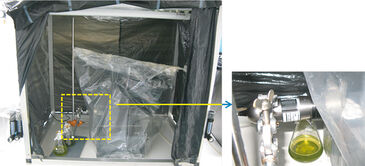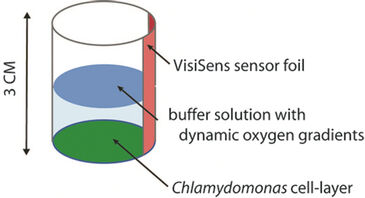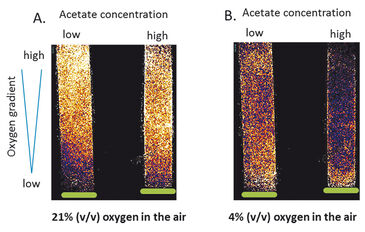Watch tutorials, webinars and informative videos about PreSens optical sensor systems.
Measuring Oxygen Gradients above a Respiratory Active Algal Cell Layer
VisiSens Applied to Detect Dynamic Oxygen Fluctuations over Time
Cindy Ast, Carola Päpke, and Joost T. van Dongen
Max-Planck-Institute of Molecular Plant Physiology, Potsdam-Golm, Germany
Oxygen gradients in buffer solution above a monolayer of Chlamydomonas reinhardtii have been visualized with the VisiSens system. Aim of the experiment was to determine, if respiring cells are able to adapt their oxygen consumption rate to oxygen availability around the cells. Besides different oxygen concentrations the cells were also kept in buffer solutions with either high or low concentrations of acetate. The 2D images taken with VisiSens over time suggest that the respiratory oxygen consumption can vary with different oxygen concentration in the environment of the cells. However, it was found that nutrient availability has much stronger influence on the cells than oxygen availability.
Molecular oxygen is an essential substrate for respiratory energy (ATP) production. If the oxygen availability to a cell becomes too low, one dramatic consequence of this is that the ATP production will get hampered with death of the cell as ultimate consequence. Even though plants are able to produce oxygen themselves in the light via photosynthesis, plant cells are very vulnerable to low-oxygen stress. Since plants do not have an efficient distribution system to transport oxygen to the tissues where it is needed most, internal oxygen concentrations within plants can drop to very low levels.
Plants are described to possess several adaptive metabolic responses to low-oxygen stress. The activity of energy consuming storage metabolism is down-regulated, and metabolic fluxes switch to the most economic pathway. As a consequence of these metabolic adaptations, the production rate of ATP can be reduced and the oxygen demand of cellular respiration is diminished. Currently, it is being discussed whether this reduction of respiratory oxygen consumption upon hypoxia is a direct consequence of oxygen depletion, or whether pro-active regulation mechanisms exist to save oxygen and to prevent the cells from running into anoxia (i. e. total absence of oxygen). A pre-requisite for pro-active regulation of oxygen consumption is a cellular mechanism to determine the oxygen availability. Indeed, a sensor or signaling pathway for the availability of molecular oxygen within plant cells was recently discovered. However, experimental proof of plant cells being able to save on oxygen by decreasing their consumption during periods of low-oxygen stress remains to be produced.
Since it is hardly possible to determine the true oxygen concentration in and directly around multicellular plant tissues without disturbing the tissue, we decided to use a liquid cell culture of the alga Chlamydomonas reinhardtii for these experiments. The VisiSens senor foil was attached to the inner surface of the test vessel to determine oxygen fluctuations in the medium above the cells, and investigate whether respiring plant cells are able to adapt their oxygen consumption rate to varying oxygen availability in their environment.
Materials & Methods
Cells of a non-motile strain of the green alga Chlamydomonas rheinhardtii were pipetted in two straight glass vials. Within about 4 hours, the cells built a homogeneous cell layer on the bottom of the vial. The supernatant was carefully pipetted off, and replaced by a buffer with either a high or a low concentration of acetate as respiratory substrate. The test vials were placed in the dark in a transparent plastic bag that could be filled with pre-mixed air that contained different oxygen concentrations (see Fig. 1). The oxygen concentration in the buffer column above the cells was continuously monitored using a small stripe of VisiSens oxygen sensor foil that was attached to the inside of the glass vial (see Fig. 2). 21 % (v/v) and 4 % (v/v) oxygen concentration in the air flow was applied and measurements were taken for 24 hours.
Oxygen Consumption of Algal Cells
Within the buffer column above the algal cell layer, an oxygen gradient built up when the oxygen concentration in the air around the glass vials was kept at 21 % (v/v) (see Fig. 3 A). The steepness of the gradient did not correlate with the carbonhydrate nutrient concentration in the buffer solution. However, when the oxygen concentration around the vial was decreased to 4 % (v/v), the oxygen concentration in the buffer dropped rapidly, and a homogeneous oxygen distribution was observed throughout the entire vial. Interestingly, the oxygen concentration in the vial that was supplied with a low acetate concentration remained higher than in the vial with high acetate concentration. Apparently, the low nutrient concentration in combination with low oxygen levels resulted in a decreased oxygen consumption rate as compared to cells provided with high nutrient availability.
Conclusion
From this experiment it can be concluded that the rate of respiratory oxygen consumption can vary upon environmental constraints, but the nutrient availability has a more dramatic impact than the oxygen availability. The VisiSens system allowed visualizing oxygen concentrations above the algal cell layer, and the recorded images allowed first conclusions on oxygen consumption in plant cells. The device is easy to apply and can generate valuable data when investigating oxygen consumption rates in plant cells. Especially the opportunity to monitor changes not only over longer time periods but also two dimensionally is a great advantage.





